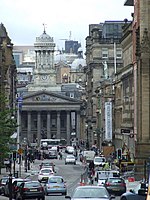The Ramshorn
Category A listed buildings in GlasgowChinese-language educationEducation in GlasgowFormer churches in ScotlandListed churches in Scotland ... and 4 more
Listed theatres in ScotlandTheatres in GlasgowUniversity of StrathclydeUse British English from July 2015

The Ramshorn is a former church building located on Ingram Street in the Merchant City area of Glasgow, Scotland. It is home to SCILT, Scotland's National Centre for Languages and the Confucius Institute for Scotland's Schools (CISS), both centres within the University of Strathclyde. The building is owned by the University, which bought the church in 1983 and used it as a theatre and performance space from 1992 until 2011. The former church building sits within the Ramshorn Cemetery, one of Glasgow's oldest burial grounds.
Excerpt from the Wikipedia article The Ramshorn (License: CC BY-SA 3.0, Authors, Images).The Ramshorn
Ingram Street, Glasgow Merchant City
Geographical coordinates (GPS) Address External links Nearby Places Show on map
Geographical coordinates (GPS)
| Latitude | Longitude |
|---|---|
| N 55.85969 ° | E -4.2451 ° |
Address
Ramshorn Theatre
Ingram Street 98
G1 1HE Glasgow, Merchant City
Scotland, United Kingdom
Open on Google Maps







